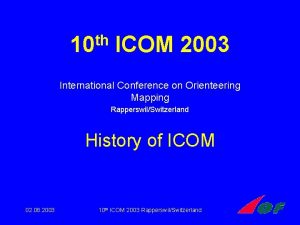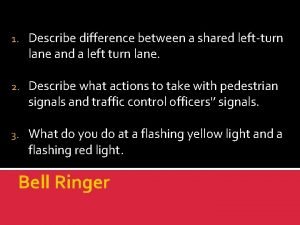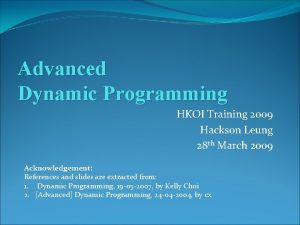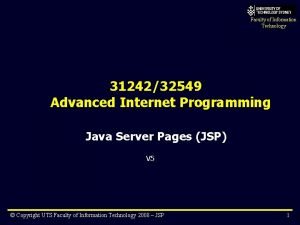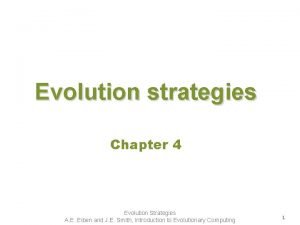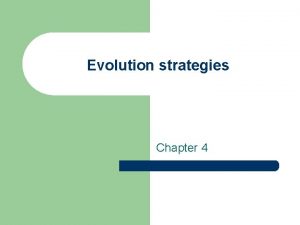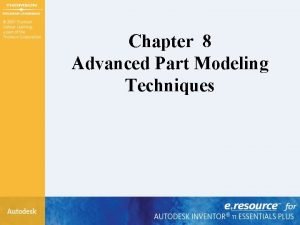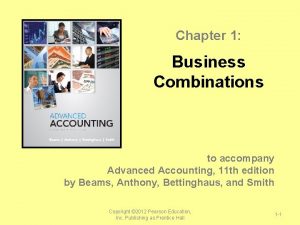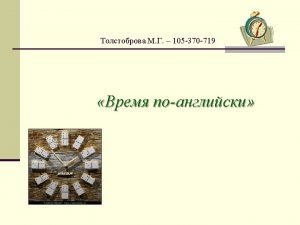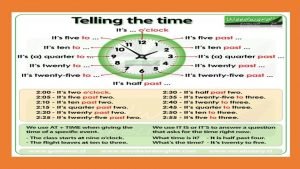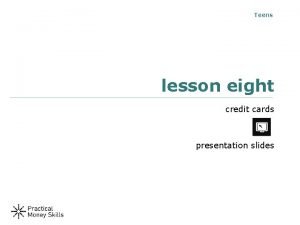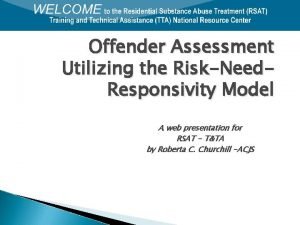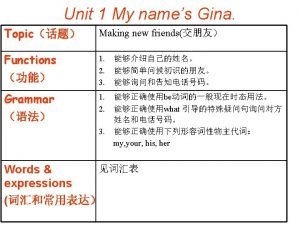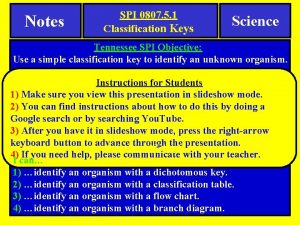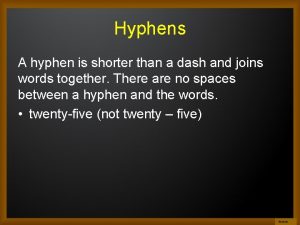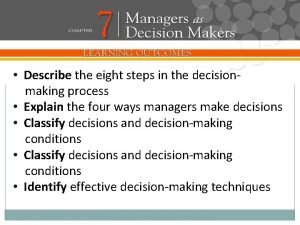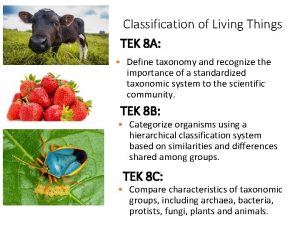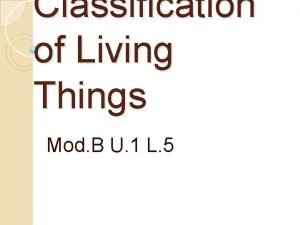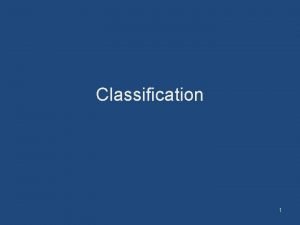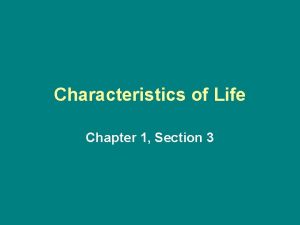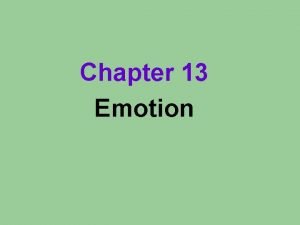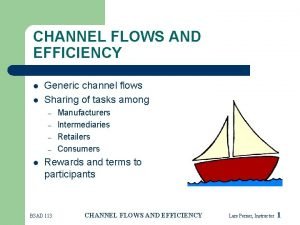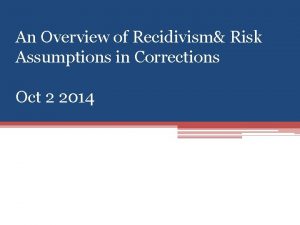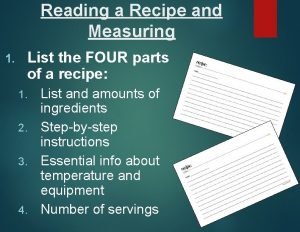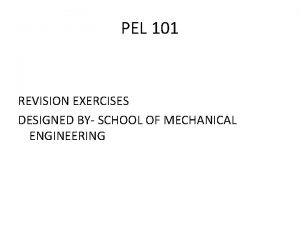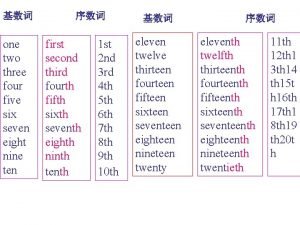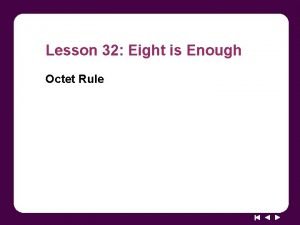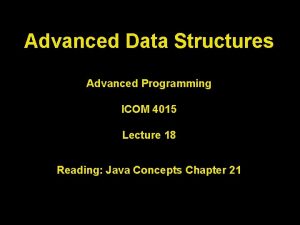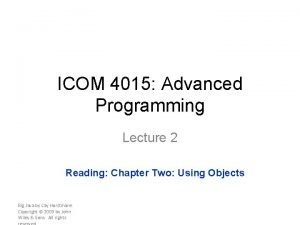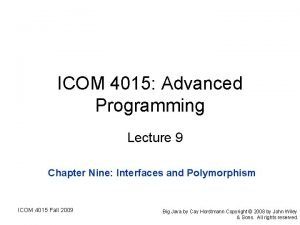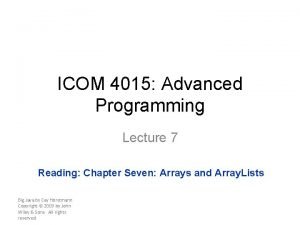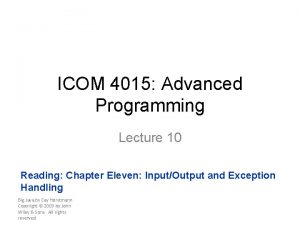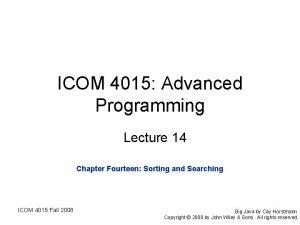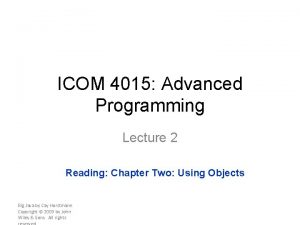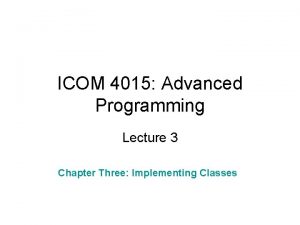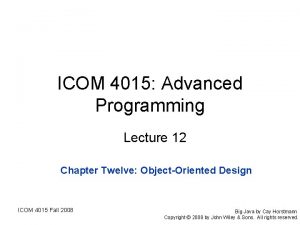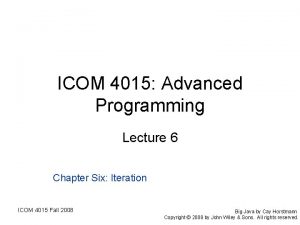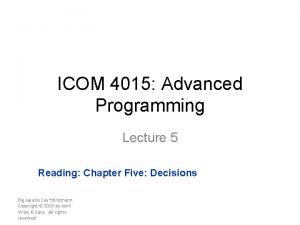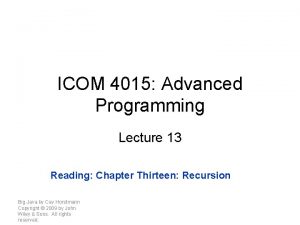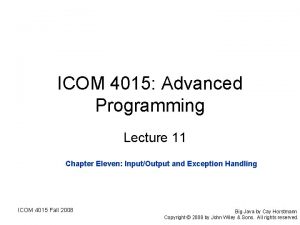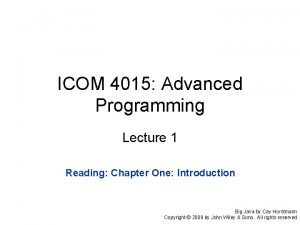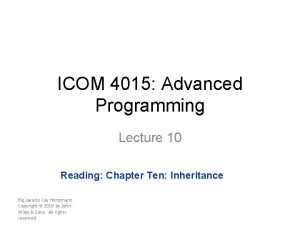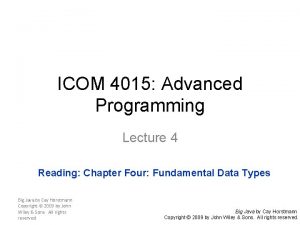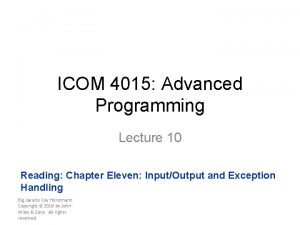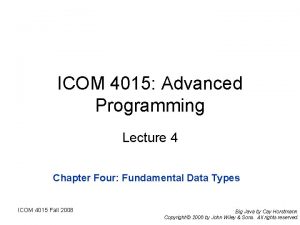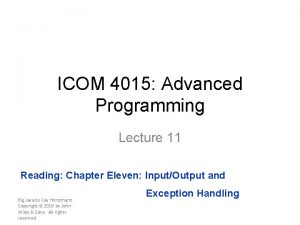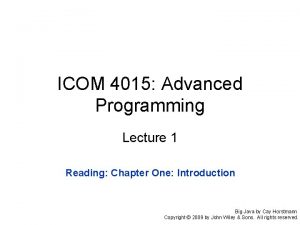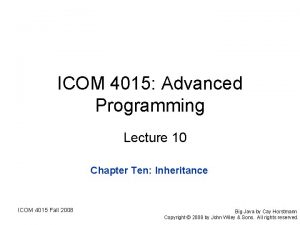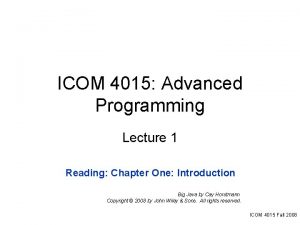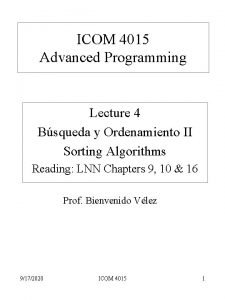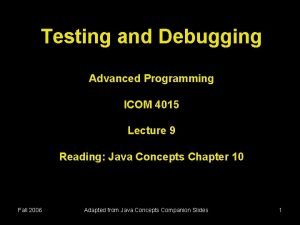ICOM 4015 Advanced Programming Lecture 8 Chapter Eight
















































































- Slides: 80

ICOM 4015: Advanced Programming Lecture 8 Chapter Eight: Designing Classes ICOM 4015 Fall 2008 Big Java by Cay Horstmann Copyright © 2008 by John Wiley & Sons. All rights reserved.

Chapter Eight: Designing Classes Big Java by Cay Horstmann Copyright © 2008 by John Wiley & Sons. All rights reserved.

Chapter Goals • To learn how to choose appropriate classes to implement • To understand the concepts of cohesion and coupling • To minimize the use of side effects • To document the responsibilities of methods and their callers with preconditions and postconditions • To understand the difference between instance methods and static methods • To introduce the concept of static fields Contined Big Java by Cay Horstmann Copyright © 2008 by John Wiley & Sons. All rights reserved.

Chapter Goals (cont. ) • To understand the scope rules for local variables and instance fields • To learn about packages • To learn about unit testing frameworks Big Java by Cay Horstmann Copyright © 2008 by John Wiley & Sons. All rights reserved.

Choosing Classes • A class represents a single concept from the problem domain • Name for a class should be a noun that describes concept • Concepts from mathematics: Point Rectangle Ellipse • Concepts from real life: Bank. Account Cash. Register Big Java by Cay Horstmann Copyright © 2008 by John Wiley & Sons. All rights reserved.

Choosing Classes • Actors (end in -er, -or) – objects do some kinds of work for you Scanner Random // better name: Random. Number. Generator • Utility classes – no objects, only static methods and constants Math • Program starters: only have a main method • Don't turn actions into classes: Paycheck is a better name than Compute. Paycheck Big Java by Cay Horstmann Copyright © 2008 by John Wiley & Sons. All rights reserved.

Self Check 8. 1 What is the rule of thumb for finding classes? Answer: Look for nouns in the problem description. Big Java by Cay Horstmann Copyright © 2008 by John Wiley & Sons. All rights reserved.

Self Check 8. 2 Your job is to write a program that plays chess. Might Chess. Board be an appropriate class? How about Move. Piece? Answer: Yes (Chess. Board) and no (Move. Piece). Big Java by Cay Horstmann Copyright © 2008 by John Wiley & Sons. All rights reserved.

Cohesion • A class should represent a single concept • The public interface of a class is cohesive if all of its features are related to the concept that the class represents • This class lacks cohesion: public class Cash. Register { public void enter. Payment(int dollars, int quarters, int dimes, int nickels, int pennies). . . public static final double NICKEL_VALUE = 0. 05; public static final double DIME_VALUE = 0. 1; public static final double QUARTER_VALUE = 0. 25; . . . } Big Java by Cay Horstmann Copyright © 2008 by John Wiley & Sons. All rights reserved.

Cohesion Cash. Register, as described above, involves two concepts: cash register and coin Solution: Make two classes: public class Coin { public Coin(double a. Value, String a. Name) {. . . } public double get. Value() {. . . } public class Cash. Register { public void enter. Payment(int coin. Count, Coin coin. Type) {. . . } Big Java by Cay Horstmann Copyright © 2008 by John Wiley & Sons. All rights reserved.

Coupling • A class depends on another if it uses objects of that class • Cash. Register depends on Coin to determine the value of the payment • Coin does not depend on Cash. Register • High Coupling = many class dependencies • Minimize coupling to minimize the impact of interface changes • To visualize relationships draw class diagrams • UML: Unified Modeling Language. Notation for object-oriented analysis and design Big Java by Cay Horstmann Copyright © 2008 by John Wiley & Sons. All rights reserved.

Coupling Big Java by Cay Horstmann Copyright © 2008 by John Wiley & Sons. All rights reserved.

High and Low Coupling Between Classes Big Java by Cay Horstmann Copyright © 2008 by John Wiley & Sons. All rights reserved.

Self Check 8. 3 Why is the Cash. Register class from Chapter 4 not cohesive? Answer: Some of its features deal with payments, others with coin values. Big Java by Cay Horstmann Copyright © 2008 by John Wiley & Sons. All rights reserved.

Self Check 8. 4 Why does the Coin class not depend on the Cash. Register class? Answer: None of the coin operations require the Cash. Register class. Big Java by Cay Horstmann Copyright © 2008 by John Wiley & Sons. All rights reserved.

Self Check 8. 5 Why should coupling be minimized between classes? Answer: If a class doesn't depend on another, it is not affected by interface changes in the other class. Big Java by Cay Horstmann Copyright © 2008 by John Wiley & Sons. All rights reserved.

Accessors, Mutators and Immutable Classes • Accessor: does not change the state of the implicit parameter double balance = account. get. Balance(); • Mutator: modifies the object on which it is invoked account. deposit(1000); • Immutable class: has no mutator methods (e. g. , String) String name = "John Q. Public"; String uppercased = name. to. Upper. Case(); // name is not changed • It is safe to give out references to objects of immutable classes; no code can modify the object at an unexpected time Big Java by Cay Horstmann Copyright © 2008 by John Wiley & Sons. All rights reserved.

Self Check 8. 6 Is the substring method of the String class an accessor or a mutator? Answer: It is an accessor – calling substring doesn't modify the string on which the method is invoked. In fact, all methods of the String class are accessors. Big Java by Cay Horstmann Copyright © 2008 by John Wiley & Sons. All rights reserved.

Self Check 8. 7 Is the Rectangle class immutable? Answer: No – translate is a mutator. Big Java by Cay Horstmann Copyright © 2008 by John Wiley & Sons. All rights reserved.

Side Effects • Side effect of a method: any externally observable data modification public void transfer(double amount, Bank. Account other) { balance = balance - amount; other. balance = other. balance + amount; // Modifies explicit parameter } • Updating explicit parameter can be surprising to programmers; it is best to avoid it if possible Big Java by Cay Horstmann Copyright © 2008 by John Wiley & Sons. All rights reserved.

Side Effects • Another example of a side effect is output public void print. Balance() // Not recommended { System. out. println("The balance is now $" + balance); } Bad idea: message is in English, and relies on System. out It is best to decouple input/output from the actual work of your classes • You should minimize side effects that go beyond modification of the implicit parameter Big Java by Cay Horstmann Copyright © 2008 by John Wiley & Sons. All rights reserved.

Self Check 8. 8 If a refers to a bank account, then the call a. deposit(100) modifies the bank account object. Is that a side effect? Answer: No – a side effect of a method is any change outside the implicit parameter. Big Java by Cay Horstmann Copyright © 2008 by John Wiley & Sons. All rights reserved.

Self Check 8. 9 Consider the Data. Set class of Chapter 6. Suppose we add a method void read(Scanner in) { while (in. has. Next. Double()) add(in. next. Double()); } Does this method have a side effect? Answer: Yes – the method affects the state of the Scanner parameter. Big Java by Cay Horstmann Copyright © 2008 by John Wiley & Sons. All rights reserved.

Common Error: Trying to Modify Primitive Type Parameters • void transfer(double amount, double other. Balance) { balance = balance - amount; other. Balance = other. Balance + amount; } • Won't work • Scenario: double savings. Balance = 1000; harrys. Checking. transfer(500, savings. Balance); System. out. println(savings. Balance); • In Java, a method can never change parameters of primitive type Big Java by Cay Horstmann Copyright © 2008 by John Wiley & Sons. All rights reserved.

Common Error: Trying to Modify Primitive Type Parameters double savings. Balance = 1000; harrys. Checking. transfer(500, savings. Balance); System. out. println(savings. Balance); . . . void transfer(double amount, double other. Balance) { balance = balance - amount; other. Balance = other. Balance + amount; } Big Java by Cay Horstmann Copyright © 2008 by John Wiley & Sons. All rights reserved.

Common Error: Trying to Modify Primitive Type Parameters double savings. Balance = 1000; harrys. Checking. transfer(500, savings. Balance); System. out. println(savings. Balance); . . . void transfer(double amount, double other. Balance) { balance = balance - amount; other. Balance = other. Balance + amount; } Big Java by Cay Horstmann Copyright © 2008 by John Wiley & Sons. All rights reserved.

Common Error: Trying to Modify Primitive Type Parameters double savings. Balance = 1000; harrys. Checking. transfer(500, savings. Balance); System. out. println(savings. Balance); . . . void transfer(double amount, double other. Balance) { balance = balance - amount; other. Balance = other. Balance + amount; } Continued Big Java by Cay Horstmann Copyright © 2008 by John Wiley & Sons. All rights reserved.

Common Error: Trying to Modify Primitive Type Parameters (cont. ) Big Java by Cay Horstmann Copyright © 2008 by John Wiley & Sons. All rights reserved.

Common Error: Trying to Modify Primitive Type Parameters double savings. Balance = 1000; harrys. Checking. transfer(500, savings. Balance); System. out. println(savings. Balance); . . . void transfer(double amount, double other. Balance) { balance = balance - amount; other. Balance = other. Balance + amount; } Continued Big Java by Cay Horstmann Copyright © 2008 by John Wiley & Sons. All rights reserved.

Common Error: Trying to Modify Primitive Type Parameters (cont. ) Big Java by Cay Horstmann Copyright © 2008 by John Wiley & Sons. All rights reserved.

Animation 8. 1 – Trying to Modify Primitive Type Parameters Big Java by Cay Horstmann Copyright © 2008 by John Wiley & Sons. All rights reserved.

Call by Value and Call by Reference • Call by value: Method parameters are copied into the parameter variables when a method starts • Call by reference: Methods can modify parameters • Java has call by value • A method can change state of object reference parameters, but cannot replace an object reference with another Continued Big Java by Cay Horstmann Copyright © 2008 by John Wiley & Sons. All rights reserved.

Call by Value and Call by Reference (cont. ) public class Bank. Account { public void transfer(double amount, Bank. Account other. Account) { balance = balance - amount; double new. Balance = other. Account. balance + amount; other. Account = new Bank. Account(new. Balance); // Won't work } } Big Java by Cay Horstmann Copyright © 2008 by John Wiley & Sons. All rights reserved.

Call by Value Example harrys. Checking. transfer(500, savings. Account); Big Java by Cay Horstmann Copyright © 2008 by John Wiley & Sons. All rights reserved.

Preconditions • Precondition: Requirement that the caller of a method must meet • Publish preconditions so the caller won't call methods with bad parameters • /** Deposits money into this account. @param amount the amount of money to deposit (Precondition: amount >= 0) */ • Typical use: • To restrict the parameters of a method • To require that a method is only called when the object is in an appropriate state Continued Big Java by Cay Horstmann Copyright © 2008 by John Wiley & Sons. All rights reserved.

Preconditions (cont. ) • If precondition is violated, method is not responsible for computing the correct result. It is free to do anything Big Java by Cay Horstmann Copyright © 2008 by John Wiley & Sons. All rights reserved.

Preconditions • Method may throw exception if precondition violated – more in Chapter 11 if (amount < 0) throw new Illegal. Argument. Exception(); balance = balance + amount; • Method doesn't have to test for precondition. (Test may be costly) // if this makes the balance negative, it's the caller's fault balance = balance + amount; Big Java by Cay Horstmann Copyright © 2008 by John Wiley & Sons. All rights reserved.

Preconditions • Method can do an assertion check assert amount >= 0; balance = balance + amount; • To enable assertion checking: java -enableassertions My. Prog You can turn assertions off after you have tested your program, so that it runs at maximum speed • Many beginning programmers silently return to the caller if (amount < 0) return; // Not recommended; hard to debug balance = balance + amount; Big Java by Cay Horstmann Copyright © 2008 by John Wiley & Sons. All rights reserved.

Syntax 8. 1 Assertion assert condition; Example: assert amount >= 0; Purpose: To assert that a condition is fulfilled. If assertion checking is enabled and the condition is false, an assertion error is thrown. Big Java by Cay Horstmann Copyright © 2008 by John Wiley & Sons. All rights reserved.

Postconditions • Condition that is true after a method has completed • If method call is in accordance with preconditions, it must ensure that postconditions are valid • There are two kinds of postconditions: • The return value is computed correctly • The object is in a certain state after the method call is completed /** Deposits money into this account. (Postcondition: get. Balance() >= 0) @param amount the amount of money to deposit (Precondition: amount >= 0) */ • Don't document trivial postconditions that repeat the @return clause Continued Big Java by Cay Horstmann Copyright © 2008 by John Wiley & Sons. All rights reserved.

Postconditions (cont. ) amount <= get. Balance() // this is the way to state a postcondition amount <= balance // wrong postcondition formulation • Contract: If caller fulfills precondition, method must fulfill postcondition Big Java by Cay Horstmann Copyright © 2008 by John Wiley & Sons. All rights reserved.

Self Check 8. 10 Why might you want to add a precondition to a method that you provide for other programmers? Answer: Then you don't have to worry about checking for invalid values – it becomes the caller's responsibility. Big Java by Cay Horstmann Copyright © 2008 by John Wiley & Sons. All rights reserved.

Self Check 8. 11 When you implement a method with a precondition and you notice that the caller did not fulfill the precondition, do you have to notify the caller? Answer: No – you can take any action that is convenient for you. Big Java by Cay Horstmann Copyright © 2008 by John Wiley & Sons. All rights reserved.

Static Methods • Every method must be in a class • A static method is not invoked on an object • Why write a method that does not operate on an object? Common reason: encapsulate some computation that involves only numbers. Numbers aren't objects, you can't invoke methods on them. E. g. , x. sqrt() can never be legal in Java • public class Financial { public static double percent. Of(double p, double a) { return (p / 100) * a; } // More financial methods can be added here. } Continued Big Java by Cay Horstmann Copyright © 2008 by John Wiley & Sons. All rights reserved.

Static Methods (cont. ) • Call with class name instead of object: double tax = Financial. percent. Of(tax. Rate, total); • main is static – there aren't any objects yet Big Java by Cay Horstmann Copyright © 2008 by John Wiley & Sons. All rights reserved.

Self Check 8. 12 Suppose Java had no static methods. Then all methods of the Math class would be instance methods. How would you compute the square root of x? Answer: Math m = new Math(); y = m. sqrt(x); Big Java by Cay Horstmann Copyright © 2008 by John Wiley & Sons. All rights reserved.

Self Check 8. 13 Harry turns in his homework assignment, a program that plays tictac-toe. His solution consists of a single class with many static methods. Why is this not an object-oriented solution? Answer: In an object-oriented solution, the main method would construct objects of classes Game, Player, and the like. Most methods would be instance methods that depend on the state of these objects. Big Java by Cay Horstmann Copyright © 2008 by John Wiley & Sons. All rights reserved.

Static Fields • A static field belongs to the class, not to any object of the class. Also called class field • public class Bank. Account {. . . private double balance; private int account. Number; private static int last. Assigned. Number = 1000; } • If last. Assigned. Number was not static, each instance of Bank. Account would have its own value of last. Assigned. Number Continued Big Java by Cay Horstmann Copyright © 2008 by John Wiley & Sons. All rights reserved.

Static Fields (cont. ) • public Bank. Account() { // Generates next account number to be assigned last. Assigned. Number++; // Updates the static field // Assigns field to account number of this bank account. Number = last. Assigned. Number; // Sets the instance field } • Minimize the use of static fields (static final fields are ok) Big Java by Cay Horstmann Copyright © 2008 by John Wiley & Sons. All rights reserved.

Static Fields • Three ways to initialize: 1. Do nothing. Field is initialized with 0 (for numbers), false (for boolean values), or null (for objects) 2. Use an explicit initializer, such as public class Bank. Account {. . . private static int last. Assigned. Number = 1000; // Executed once, // when class is loaded } 3. Use a static initialization block • Static fields should always be declared as private Continued Big Java by Cay Horstmann Copyright © 2008 by John Wiley & Sons. All rights reserved.

Static Fields (cont. ) • Exception: Static constants, which may be either private or public class Bank. Account {. . . public static final double OVERDRAFT_FEE = 5; // Refer to it as // Bank. Account. OVERDRAFT_FEE } Big Java by Cay Horstmann Copyright © 2008 by John Wiley & Sons. All rights reserved.

A Static Field and Instance Fields Big Java by Cay Horstmann Copyright © 2008 by John Wiley & Sons. All rights reserved.

Self Check 8. 14 Name two static fields of the System class. Answer: System. in and System. out. Big Java by Cay Horstmann Copyright © 2008 by John Wiley & Sons. All rights reserved.

Self Check 8. 15 Harry tells you that he has found a great way to avoid those pesky objects: Put all code into a single class and declare all methods and fields static. Then main call the other static methods, and all of them can access the static fields. Will Harry's plan work? Is it a good idea? Answer: Yes, it works. Static methods can access static fields of the same class. But it is a terrible idea. As your programming tasks get more complex, you will want to use objects and classes to organize your programs. Big Java by Cay Horstmann Copyright © 2008 by John Wiley & Sons. All rights reserved.

Scope of Local Variables • Scope of variable: Region of program in which the variable can be accessed • Scope of a local variable extends from its declaration to end of the block that encloses it Continued Big Java by Cay Horstmann Copyright © 2008 by John Wiley & Sons. All rights reserved.

Scope of Local Variables (cont. ) • Sometimes the same variable name is used in two methods: public class Rectangle. Tester { public static double area(Rectangle rect) { double r = rect. get. Width() * rect. get. Height(); return r; } public static void main(String[] args) { Rectangle r = new Rectangle(5, 10, 20, 30); double a = area(r); System. out. println(r); } } • These variables are independent from each other; their scopes are disjoint Big Java by Cay Horstmann Copyright © 2008 by John Wiley & Sons. All rights reserved.

Scope of Local Variables • Scope of a local variable cannot contain the definition of another variable with the same name Rectangle r = new Rectangle(5, 10, 20, 30); if (x >= 0) { double r = Math. sqrt(x); // Error - can't declare another variable called r here. . . } Continued Big Java by Cay Horstmann Copyright © 2008 by John Wiley & Sons. All rights reserved.

Scope of Local Variables (cont. ) • However, can have local variables with identical names if scopes do not overlap if (x >= 0) { double r = Math. sqrt(x); . . . } // Scope of r ends here else { Rectangle r = new Rectangle(5, 10, 20, 30); // OK - it is legal to declare another r here. . . } Big Java by Cay Horstmann Copyright © 2008 by John Wiley & Sons. All rights reserved.

Scope of Class Members • Private members have class scope: You can access all members in any method of the class • Must qualify public members outside scope Math. sqrt harrys. Checking. get. Balance • Inside a method, no need to qualify fields or methods that belong to the same class Continued Big Java by Cay Horstmann Copyright © 2008 by John Wiley & Sons. All rights reserved.

Scope of Class Members (cont. ) • An unqualified instance field or method name refers to the this parameter public class Bank. Account { public void transfer(double amount, Bank. Account other) { withdraw(amount); // i. e. , this. withdraw(amount); other. deposit(amount); }. . . } Big Java by Cay Horstmann Copyright © 2008 by John Wiley & Sons. All rights reserved.

Overlapping Scope • A local variable can shadow a field with the same name • Local scope wins over class scope public class Coin {. . . public double get. Exchange. Value(double exchange. Rate) { double value; // Local variable. . . return value; } private String name; private double value; // Field with the same name } Continued Big Java by Cay Horstmann Copyright © 2008 by John Wiley & Sons. All rights reserved.

Overlapping Scope (cont. ) • Access shadowed fields by qualifying them with the this reference value = this. value * exchange. Rate; Big Java by Cay Horstmann Copyright © 2008 by John Wiley & Sons. All rights reserved.

Self Check 8. 16 Consider the deposit method of the Bank. Account class. What is the scope of the variables amount and new. Balance? Answer: The scope of amount is the entire deposit method. The scope of new. Balance starts at the point at which the variable is defined and extends to the end of the method. Big Java by Cay Horstmann Copyright © 2008 by John Wiley & Sons. All rights reserved.

Self Check 8. 17 What is the scope of the balance field of the Bank. Account class? Answer: It starts at the beginning of the class and ends at the end of the class. Big Java by Cay Horstmann Copyright © 2008 by John Wiley & Sons. All rights reserved.

Organizing Related Classes into Packages • Package: Set of related classes • To put classes in a package, you must place a line package. Name; as the first instruction in the source file containing the classes • Package name consists of one or more identifiers separated by periods Continued Big Java by Cay Horstmann Copyright © 2008 by John Wiley & Sons. All rights reserved.

Organizing Related Classes into Packages (cont. ) • For example, to put the Financial class introduced into a package named com. horstmann. bigjava, the Financial. java file must start as follows: package com. horstmann. bigjava; public class Financial {. . . } • Default package has no name, no package statement Big Java by Cay Horstmann Copyright © 2008 by John Wiley & Sons. All rights reserved.

Important Packages in the Java Library Package Purpose Sample Class java. lang Language support Math java. util Utilities Random java. io Input and output Print. Stream java. awt Abstract Windowing Toolkit Color java. applet Applets Applet java. net Networking Socket java. sql Database Access Result. Set javax. swing Swing user interface JButton org. omg. CORBA Common Object Request Broker Architecture Int. Holder Big Java by Cay Horstmann Copyright © 2008 by John Wiley & Sons. All rights reserved.

Syntax 8. 2 Package Specification package. Name; Example: package com. horstmann. bigjava; Purpose: To declare that all classes in this file belong to a particular package. Big Java by Cay Horstmann Copyright © 2008 by John Wiley & Sons. All rights reserved.

Importing Packages • Can always use class without importing java. util. Scanner in = new java. util. Scanner(System. in); • Tedious to use fully qualified name • Import lets you use shorter class name import java. util. Scanner; . . . Scanner in = new Scanner(System. in) • Can import all classes in a package import java. util. *; • Never need to import java. lang • You don't need to import other classes in the same package Big Java by Cay Horstmann Copyright © 2008 by John Wiley & Sons. All rights reserved.

Package Names and Locating Classes • Use packages to avoid name clashes java. util. Timer vs. javax. swing. Timer • Package names should be unambiguous • Recommendation: start with reversed domain name com. horstmann. bigjava edu. sjsu. cs. walters: for Bertha Walters' classes (walters@cs. sjsu. edu) • Path name should match package name com/horstmann/bigjava/Financial. java Continued Big Java by Cay Horstmann Copyright © 2008 by John Wiley & Sons. All rights reserved.

Package Names and Locating Classes (cont. ) • Path name starts with class path export CLASSPATH=/home/walters/lib: . set CLASSPATH=c: homewalterslib; . • Class path contains the base directories that may contain package directories Big Java by Cay Horstmann Copyright © 2008 by John Wiley & Sons. All rights reserved.

Base Directories and Subdirectories for Packages Big Java by Cay Horstmann Copyright © 2008 by John Wiley & Sons. All rights reserved.

Self Check 8. 18 Which of the following are packages? a. java b. java. lang c. java. util d. java. lang. Math Answer: a. No b. Yes c. Yes d. No Big Java by Cay Horstmann Copyright © 2008 by John Wiley & Sons. All rights reserved.

Self Check 8. 19 Is a Java program without import statements limited to using the default and java. lang packages? Answer: No – you simply use fully qualified names for all other classes, such as java. util. Random and java. awt. Rectangle. Big Java by Cay Horstmann Copyright © 2008 by John Wiley & Sons. All rights reserved.

Self Check 8. 20 Suppose your homework assignments are located in the directory /home/me/cs 101 (c: mecs 101 on Windows). Your instructor tells you to place your homework into packages. In which directory do you place the class hw 1. problem 1. Tic. Tac. Toe. Tester? Answer: /home/me/cs 101/hw 1/problem 1 or, on Windows, c: mecs 101hw 1problem 1 Big Java by Cay Horstmann Copyright © 2008 by John Wiley & Sons. All rights reserved.

The Explosive Growth of Personal Computers Big Java by Cay Horstmann Copyright © 2008 by John Wiley & Sons. All rights reserved.

Unit Testing Frameworks • Unit test frameworks simplify the task of writing classes that contain many test cases • JUnit: http: //junit. org Built into some IDEs like Blue. J and Eclipse • Philosophy: whenever you implement a class, also make a companion test class. Run all tests whenever you change your code Continued Big Java by Cay Horstmann Copyright © 2008 by John Wiley & Sons. All rights reserved.

Unit Testing Frameworks Big Java by Cay Horstmann Copyright © 2008 by John Wiley & Sons. All rights reserved.

Self Check 8. 21 Provide a JUnit test class with one test case for the Earthquake class in Chapter 5. Answer: Here is one possible answer, using the JUnit 4 style. public class Earthquake. Test { @Test public void test. Level 4() { Earthquake = new Earthquake(4); Assert. assert. Equals("Felt by many people, no destruction", quake. get. Description()); } } Big Java by Cay Horstmann Copyright © 2008 by John Wiley & Sons. All rights reserved.

Self Check 8. 22 What is the significance of the EPSILON parameter in the assert. Equals method? Answer: It is a tolerance threshold for comparing floating-point numbers. We want the equality test to pass if there is a small roundoff error. Big Java by Cay Horstmann Copyright © 2008 by John Wiley & Sons. All rights reserved.
 Icom ic-2730a vs kenwood tm-v71a
Icom ic-2730a vs kenwood tm-v71a Icom dstar
Icom dstar Icom
Icom Icom
Icom A polygon with eight sides and eight angles
A polygon with eight sides and eight angles A short section of corrugated roadway that warns of hazards
A short section of corrugated roadway that warns of hazards Tunggakan gaji tahun semasa
Tunggakan gaji tahun semasa 01:640:244 lecture notes - lecture 15: plat, idah, farad
01:640:244 lecture notes - lecture 15: plat, idah, farad Advanced inorganic chemistry lecture notes
Advanced inorganic chemistry lecture notes C programming lecture
C programming lecture Advanced dynamic programming
Advanced dynamic programming Advanced internet programming
Advanced internet programming A simple assembly scheme in system software
A simple assembly scheme in system software Advanced assembler directives in system programming
Advanced assembler directives in system programming Advanced programming in java
Advanced programming in java Perbedaan linear programming dan integer programming
Perbedaan linear programming dan integer programming Greedy programming vs dynamic programming
Greedy programming vs dynamic programming Components of system programming
Components of system programming Integer programming vs linear programming
Integer programming vs linear programming Perbedaan linear programming dan integer programming
Perbedaan linear programming dan integer programming The great gatsby 8 summary
The great gatsby 8 summary Lord of the flies chapter 8 notes
Lord of the flies chapter 8 notes Management fifteenth edition
Management fifteenth edition Human resources introduction
Human resources introduction Human resource management lecture chapter 1
Human resource management lecture chapter 1 Chapter 6 advanced shielded metal arc welding
Chapter 6 advanced shielded metal arc welding Pseudocde
Pseudocde Advanced evolution chapter 4
Advanced evolution chapter 4 Advanced part modeling
Advanced part modeling Advanced accounting chapter 1
Advanced accounting chapter 1 Five past quarter
Five past quarter What was eight years ago
What was eight years ago Quarter to five
Quarter to five The 8 sectors of tourism
The 8 sectors of tourism Eight elements of culture
Eight elements of culture Lesson eight credit cards
Lesson eight credit cards Answer
Answer Eight generic channel flows
Eight generic channel flows Criminogenico
Criminogenico John pushes hector on a plastic toboggan
John pushes hector on a plastic toboggan Eight balloons poem
Eight balloons poem Five six seven eight
Five six seven eight Central eight risk factors
Central eight risk factors Zero one two three four five
Zero one two three four five What are the 8 levels of classification
What are the 8 levels of classification It's not how smart you are it's how you are smart
It's not how smart you are it's how you are smart Eight basic puzzles about financial structure
Eight basic puzzles about financial structure Letter from birmingham jail soapstone
Letter from birmingham jail soapstone In a school assembly eight children
In a school assembly eight children Long lasting hyphen
Long lasting hyphen Archetypes of villains
Archetypes of villains Factors of 24
Factors of 24 Evolution of eia
Evolution of eia Timeliness news stories
Timeliness news stories Sea eight maritime services
Sea eight maritime services Eight brief tales of lovers questions and answers
Eight brief tales of lovers questions and answers Importance of qualitative research
Importance of qualitative research Decision making steps grade 8
Decision making steps grade 8 Shape with 8 vertices
Shape with 8 vertices List the eight great ideas invented by computer architects
List the eight great ideas invented by computer architects The 8 taxonomic groups
The 8 taxonomic groups 8 levels of classification
8 levels of classification Scientific taxonomy
Scientific taxonomy 8 characteristics of life
8 characteristics of life What are the eight levels of classification
What are the eight levels of classification Basic and secondary emotions
Basic and secondary emotions Zero based channel
Zero based channel Pembalut kepala
Pembalut kepala Central eight risk factors
Central eight risk factors I think our country sinks beneath the yoke
I think our country sinks beneath the yoke Army eight step training model
Army eight step training model Sarah's uncle's car was found
Sarah's uncle's car was found Ten twenty thirty worksheet
Ten twenty thirty worksheet What are the eight steps to following a recipe correctly
What are the eight steps to following a recipe correctly At wendy's washateria all of the dryer
At wendy's washateria all of the dryer Three four five six seven
Three four five six seven Eight is enough octet rule
Eight is enough octet rule What are the 8 stages of sdlc?
What are the 8 stages of sdlc? Bell and harts eight causes of conflict
Bell and harts eight causes of conflict Nine two one
Nine two one Confedency
Confedency


